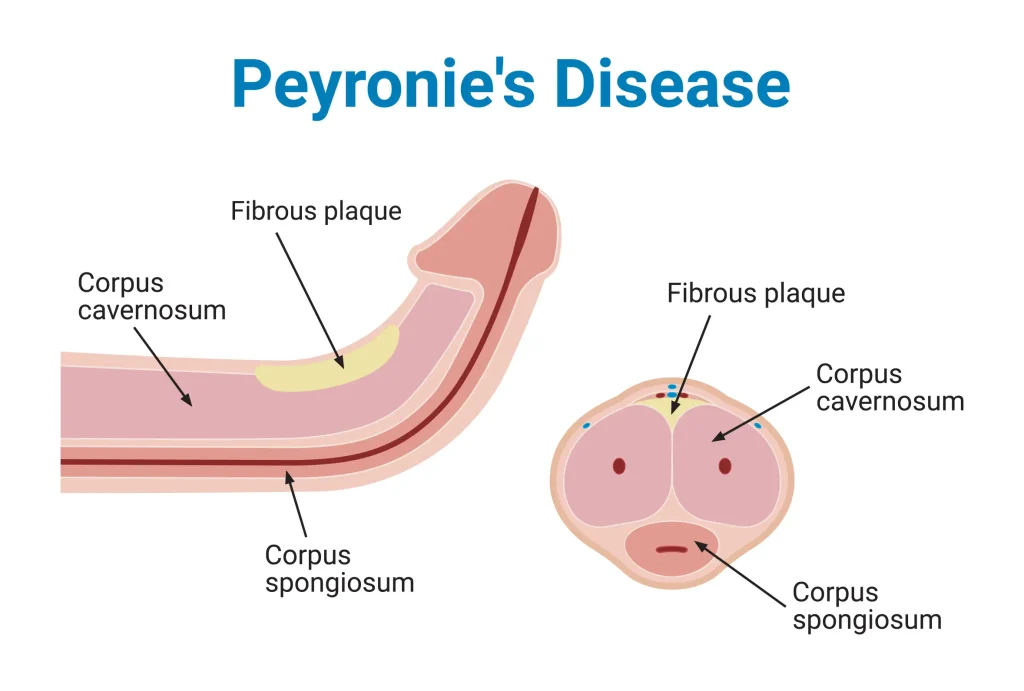Now Accepting New Patients. Contact Us Today To Schedule Your Visit.
Peyronie’s Disease is a condition resulting from the way the body heals wounds. Injuries or damage to the outer tissues of the penis lead to the formation of scar-like tissue (plaque). Unlike the plaques associated with heart disease, Peyronie’s plaques are mainly composed of collagen.
Plaques can alter the shape of the penis, causing it to curve, indent (forming an hourglass shape), or become shorter. In some cases, these changes can make intercourse difficult or impossible, accompanied by feelings of pain.

It is crucial to consult with a urologist specializing in Peyronie’s Disease at the onset of any symptoms. Early treatment yields better results.
Peyronie’s disease typically occurs in two phases — the acute (active) phase and the chronic (stable) phase.
The initial phase, lasting up to about 18 months, involves significant changes in the penis. Plaques form, leading to alterations in the shape of the erect penis, with curvature often worsening. Some men may experience painful erections. Pain during the acute phase may occur without an erection due to inflammation, and later, it may result from tension on the plaques during erection.
The chronic or stable phase usually begins within 12-18 months after symptoms first appear. During this phase, the plaques and curvature become stable and are unlikely to worsen, though improvement is also unlikely. Penile pain often diminishes or disappears, but erectile dysfunction (ED) may develop or worsen.
Urologists often choose non-surgical treatments during the early or active phase of Peyronie’s disease. Men with small plaques, minimal curvature, no pain, and no sexual issues may not require treatment. For those needing treatment, options include:
Injecting drugs directly into the plaque provides high doses of the drug to the affected area. This is a suitable option for men with acute disease or uncertainty about surgery. Examples of injections include collagenase, verapamil, and interferon, each serving different purposes.
Surgery may be considered for men with severe penile curvature that hinders sexual activity. Doctors typically wait at least 6 months before recommending surgery, and it becomes an option when the plaque and curvature stabilize. Surgical procedures include plication, incision and grafting, and penile implant surgery.
No oral treatments have been proven more effective than a placebo for Peyronie’s. Some oral treatments lack evidence, while others like colchicine, pentoxifylline, potassium aminobenzoate, and co-enzyme Q10 require further study.
Several options, such as penile traction, hyperthermia, and various topical applications, need further research to determine their effectiveness.
Certain treatments, including electromotive therapy, radiation therapy, and extracorporeal shock wave therapy (ESWT), have been shown not to improve curvature or plaque size.
Considering potential risks is essential, especially for treatments not proven more effective than doing nothing.
Approximately half of men with Peyronie’s Disease report symptoms of depression. Seeking support from a therapist or counselor can help manage depression, anxiety, and intimacy issues.
All content, materials, and imagery on the Lawrence Jenkins MD website are protected by copyright law. The intellectual property, including but not limited to text, graphics, logos, images, and multimedia elements, is the exclusive property of Lawrence Jenkins MD unless otherwise stated.
Disclaimer : All content posted on this website is commentary or opinion. This website does not give or attempt to give medical advice and your personal information is not stored. THIS WEBSITE IS NOT DESIGNED TO – AND DOES NOT – PROVIDE MEDICAL ADVICE